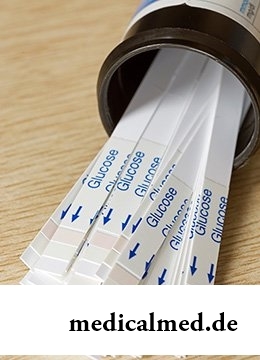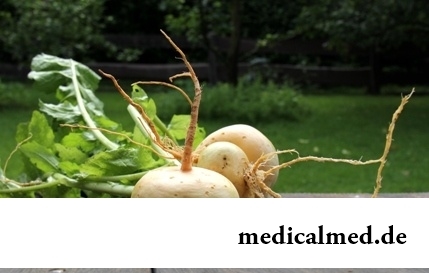





Glycemia
 The term "glycemia" was offered in the 19th century by the French physiologist Claude Bernard for designation of an indicator of content of sugar in blood.
The term "glycemia" was offered in the 19th century by the French physiologist Claude Bernard for designation of an indicator of content of sugar in blood.
Level of a glycemia can be a miscellaneous: normal, lowered or raised. Normal concentration of glucose is equal in blood to 3,5-5,5 mmol/l, and stability of this indicator as, otherwise, the brain and all organism in general cannot function in the correct mode is important.
If sugar is lowered, speak about a so-called hypoglycemia and when its level is higher than norm – about a hyperglycemia. Both states are dangerous: at an exit for a framework of critical marks of people can faint and even to fell into a coma.
Glycemia symptoms
At normal concentration of glucose in blood symptoms of a glycemia are not shown as the organism works well and copes with loadings. When the norm is broken, there are most various displays of pathology.
At exceeding of figures of admissible value (hyperglycemia) glycemia symptoms following:
- Strong thirst;
- Skin itch;
- Frequent urination;
- Irritability;
- Bystry fatigue;
- Loss of consciousness and coma (in especially hard cases).
The condition of a hyperglycemia is peculiar first of all a sick diabetes mellitus. At such patients because of absence or deficit of own insulin after meal sugar in blood (a postprandialny glycemia) raises.
Certain changes in functioning of all organism arise also at a hypoglycemia. It should be noted that sometimes such state is peculiar to absolutely healthy people, for example, at big exercise stresses or very rigid diet, and also or the overdose of glucose-lowering drugs arose a sick diabetes mellitus if the dose of insulin is picked incorrectly up.
In this case glycemia symptoms following:
- Strong feeling of hunger;
- Dizziness and general weakness;
- Nausea;
- Lack of coordination of movements;
- Coma or loss of consciousness (in extreme cases).
Determination of level of a glycemia
Apply two main ways to determination of level of a glycemia:
- Measurement of sugar on blood test;
- The tolerance test to glucose.
The first revealed indicator – disturbance of a glycemia on an empty stomach which not always testifies to a disease. It is quite widespread way which consists in definition of concentration of glucose in capillary blood (from a finger) after starvation within eight hours (as a rule, in the morning after a dream).
The broken glycemia on an empty stomach, or NGN – a state at which the content of sugar in plasma (or blood) on an empty stomach exceeds normal level, but below the threshold value which is a diagnostic character of diabetes. The indicator in 6,2 mmol/l is considered boundary.
It is necessary to know that for confirmation of forecasts and statement of the exact diagnosis, it is necessary to conduct a research not less than two times, and it is desirable in different days to avoid situational mistakes. For reliability of results of the analysis it is important not to accept the drugs influencing a hormonal background.
For specification of a state, except identification of level of a glycemia on an empty stomach, it is important to conduct the second additional research: the tolerance test to glucose. An operations procedure at this test following:
- Standard blood test on an empty stomach;
- Reception by the patient of 75 g of glucose (usually in the form of aqueous solution);
- Repeated blood sampling and the analysis in two hours after peroral loading.
The received figures to 7,8 mmol/l are considered as normal if they reach 10,3 mmol/l, it is desirable to undergo additional inspection. A sign of a diabetes mellitus is exceeding of border in 10,3 mmol/l.
Treatment of a glycemia
At disturbance of a glycemia treatment is appointed by the doctor, however correction of a way of life is the cornerstone of all therapeutic influences. Sometimes, especially in hard cases, medical supplies are used.
 The most important in treatment of a glycemia is an observance of a diet. Patients with a diabetes mellitus have to pay special attention to a glycemic index of food stuffs and use only those from them which are characterized by a low index. Both in case of a hyperglycemia, and at a condition of a hypoglycemia it is necessary to adhere to fractional food, that is to eat often, but gradually. At a diet there have to be complex carbohydrates which are long acquired and provide an organism with energy for a long time. "Bad" carbohydrates, especially sugar and products from white flour, it is recommended to exclude from the menu completely. Proteins in food have to be in enough, and here fats should be limited.
The most important in treatment of a glycemia is an observance of a diet. Patients with a diabetes mellitus have to pay special attention to a glycemic index of food stuffs and use only those from them which are characterized by a low index. Both in case of a hyperglycemia, and at a condition of a hypoglycemia it is necessary to adhere to fractional food, that is to eat often, but gradually. At a diet there have to be complex carbohydrates which are long acquired and provide an organism with energy for a long time. "Bad" carbohydrates, especially sugar and products from white flour, it is recommended to exclude from the menu completely. Proteins in food have to be in enough, and here fats should be limited.
Not less important point in treatment of a glycemia is physical activity and the weight reduction accompanying it. Recent large-scale researches in the USA, China and Finland allowed to assume that even moderate weight loss and only 30-minute daily walk reduce risk of a disease of a diabetes mellitus by more than two times.
Often symptoms of a glycemia are not shown or contact other diseases, being found in a random way. In this situation even at subjectively good health of the patient it is impossible to refuse treatment.
It should be noted that sometimes the glycemia is caused by heredity therefore to persons with predisposition to diseases of endocrine character, it is regularly recommended to take a blood test on the analysis.
Work which to the person not to liking, is much more harmful to his mentality, than lack of work in general.

High temperature - a frequent symptom of such widespread diseases as a SARS, quinsy, pneumonia, etc. To reduce heat, облег...
Section: Articles about health
Ability of an organism to resist to adverse environmental factors (to impact of temperature drops, humidity and pressure, to the attacks of causative organisms, etc.) directly depends on what the person eats. Business here not only in, that C...
Section: Articles about health
Turnip, radish, horse-radish – once these and other products enjoyed wide popularity at our ancestors, being not only the food sating an organism but also the medicines curing of many diseases. Unfortunately, the use of some of them got out of fashion long ago, and once favourite plants and vegetables almost ceased to make a contribution to human health. Inclusion of such products in a modern diet − an effective measure of prevention and treatment of diseases which seldom suffered...
Section: Articles about health
All know that self-treatment is dangerous. However absolutely it is almost impossible to do without it. Rate of modern life not on...
Section: Articles about health
Many of us, probably, noticed more than once that from intellectual loadings at some point the brain as though "overheats" and "assimilation" of information is strongly slowed down. Especially this problem urgent for persons of age becomes more senior than fifty years. "It is already bad with...
Section: Articles about health
More than a half of the married couples which faced prostatitis – leave. The new broadcast "Female View of Prostatitis" will help to learn – whether you have or your relatives problems....
Section: Articles about health
It seems, quite recently you brought the baby from maternity hospital, but time flew by, and here it is already going to join the first...
Section: Articles about health
Osteoporosis this general disease which main sign is decrease in density of a bone tissue. On distribution width it takes the fourth place among noninfectious diseases. The illness develops at mature age more often: in our country to them harvest seasons...
Section: Articles about health
Bulimia and anorexia, are heavy deviations of a feeding behavior, become a cause of death of patients much more often than all other nervous breakdowns combined. In 60% of cases two illnesses accompany each other: patients feel horror before danger of set of excess weight and try to refuse as often as possible food, but periodically suffer from attacks of sudden hunger and an uncontrollable overeating. Each patient with anorexia and bulimia needs the help qualified пс...
Section: Articles about health
At this plant there are a lot of names: tuberiferous sunflower, Jerusalem artichoke, solar root, earth pear. Contrary to spread...
Section: Articles about health
Cystitis, or inflammation of a mucous membrane of a bladder, this very widespread disease which, owing to some features of a structure of bodies of urinogenital system, women have approximately four times more often than men. In the main risk group...
Section: Articles about health
Aging — natural and inevitable process. Over time our skin loses elasticity, on it saggings are formed, the face form loses former clearness. The procedure of nitevy lifting (nitevy tightening) can successfully solve this problem. In order that it is better to get acquainted with this popular procedure, we will tell you 6 cognitive facts about it....
Section: Articles about health
Statistically cystitis 25-30% of women up to 40 years have. With age this indicator raises, besides many do not get in to become...
Section: Articles about health
All of us, unfortunately, should face flu nearly an every year. It would seem, so frequent disease has to be studied already up and down, and each person, at least once by it had (and the number of such people in our country aims at 100%), a dolzha...
Section: Articles about health
Use of medicinal plants in therapy is urgent today, more than ever. The drugs made of curative herbs cannot replace completely modern synthetic drugs, but their use becomes frequent serious help in simplification of a course of many illnesses and improvement of quality of life of chronic patients....
Section: Articles about health
The metabolism at each person proceeds in own way. However dependence between the speed of this process and disposal from superfluous in...
Section: Articles about health
Such trouble as the milkwoman's attack, at least once in life happened almost to each woman. Prevalence of a disease is explained by the fact that the causative agent of an illness belongs to the so-called opportunistic microflora living on mucous an obol...
Section: Articles about health
Heart disease and blood vessels lead to disturbance of blood supply of bodies and fabrics that involves failures in their work, deterioration in health of the person, decrease in its working capacity and standard of living. Annually more than 17 million inhabitants of our planet perish from pathologies such....
Section: Articles about health
It would seem, about it there can be no disagreements: water is necessary for a human body for normal zhiznedeyatet...
Section: Articles about health
Contrary to popular belief, the multiple sclerosis (MS) is not connected neither with sclerous changes of walls of vessels, nor with age forgetfulness and problems with concentration of attention. This disease has the autoimmune nature. Pathological process of a vyrazh...
Section: Articles about health
For the city dweller the fitness is the most convenient sport. It is enough to acquire the subscription to the gym to get access to various apparatuses and an opportunity to train under the leadership of the experienced consultant. Many consider fitness the best way of maintenance of physical shape and receiving dynamic loads which the people occupied preferential with brainwork so need. Nevertheless, representations of most of consumers of similar services about специф...
Section: Articles about health
Separate food - the system of meal based on digestion physiology which is carried to improvement methods. In opinion д...
Section: Articles about health
Tea is loved and use almost everything. This drink has tonic properties, contains the tannins capable to suppress activity of causative organisms. Recently great popularity was gained by teas with vegetable additives. Лечеб...
Section: Articles about health
Wood louse – the ordinary-looking unpretentious plant extended in all territory of our country. It quickly expands, and sometimes fills sites, bringing a lot of chagrin to gardeners. Perhaps, they would be upset less if knew that the wood louse is valuable medicinal raw materials. A, C and E vitamins, organic acids, tannins, wax, saponins, lipids, mineral salts and essential oils are its part....
Section: Articles about health
Life does not indulge the modern woman special emotional comfort and carelessness. Fatigue, troubles at work, misunderstanding...
Section: Articles about health
Diapers for adults – individual one-time means of hygiene which in some situations is irreplaceable and from such situations any person is not insured. Though nobody perceives need of their use with enthusiasm, however without it to a sra...
Section: Articles about health
Condition of lips (their morbidity, outward) – one of indicators of health of the person. The peeling, dryness, pallor, and also cracks in corners of a mouth can be not only the cosmetic shortcoming which arose owing to physical damages and weather conditions but also the satellite of some diseases and disturbances in an organism needing treatment. Let's consider 10 possible reasons of emergence of angular cracks (perleches) in corners of a mouth and ways of their elimination....
Section: Articles about health
